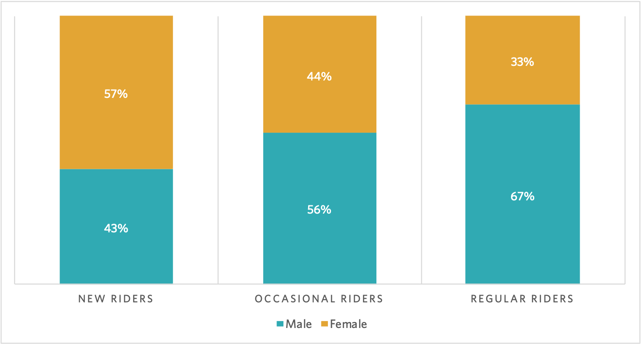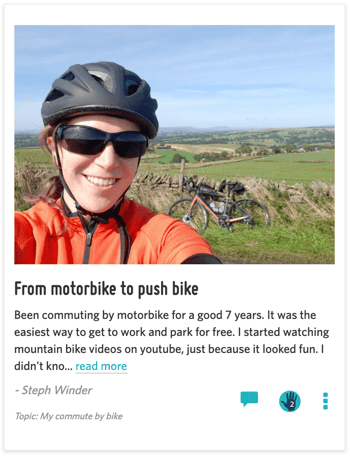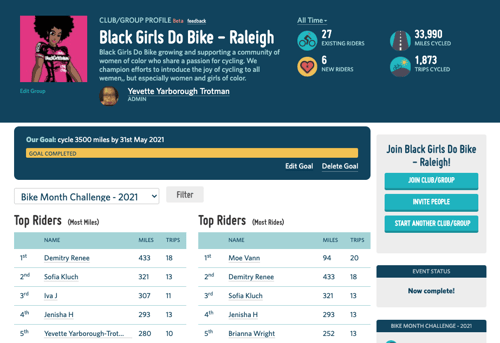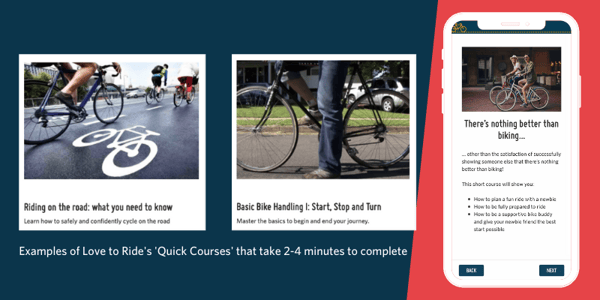As part of our mission to get more people riding bikes, we’re constantly diving into our data to further improve our approach.
Did you realise that women are three times more likely than men to cite a lack of confidence as a barrier to riding? Thankfully, we have tried and tested methods that support more women overcome their barriers.
Read on to find out more about addressing the gender balance in biking.
Who takes part in Love to Ride programs?

Around 40% of Love to Ride riders are female, but the majority of them are new riders.
What we can see is that women are clearly interested in riding. The current gender split we see in regular riders (almost 70% are men) isn’t necessarily a lack of interest.
When a person joins Love to Ride, they do a short baseline survey. This allows us to learn more about the individual and what they need to bike more comfortably and more often. As part of that survey we capture their real and perceived barriers to riding.
Looking at this data, we can see the different barriers perceived by men and women are starkly different. Women are 3 times more likely to cite that they do not feel confident enough to cycle compared with men. They’re also more likely to cite route safety concerns as a barrier as well. External barriers like needing to fix their bike or not owning one is more commonly flagged by men.
At Love to Ride we use behavior change theory and techniques to design our programs and to bake tools into our platform that are successful in encouraging more people to ride, more often.
We’ll take a look at a few of the features available on the Love to Ride platform and how these are especially valuable in helping us bridge the gender cycling gap and encourage more women to ride.
1️⃣ The encouraging power of stories
Stories are a key part of how we communicate day to day and they allow us to make sense of the world we experience. We regularly celebrate the stories we receive at Love to Ride. Within the world of behaviour change, the power of stories is invaluable.
Hearing other people’s experiences of bike riding helps to shape societal norms surrounding who a ‘typical cyclist’ is.
Stories allow women of all ages and backgrounds to see that riding is for them. They are able to liken themselves to other riders and are invited into a space where they might not have previously felt welcome.



Alongside our Stories feed we also directly mobilize women who are regular riders to help close the gap. We encourage them to invite a new rider to join them for a ride and take part in our campaigns. We even have the educational tools to ensure they feel confident enough to do this (more on our Quick Courses below).
2️⃣ Support from Clubs & Groups
We have more than 2,900 clubs and groups registered worldwide, many of which are women-only groups such as the Strathaven Breeze Birds in Scotland and Black Girls Do Bike in North Carolina, USA. Behavioral science tells us that social support is important when forming a new habit or increasing our physical activity. It’s noted that men tend to participate in more physical activity than women and generally receive more social support (Edwards and Sackett, 2016).
Supporting local cycling groups and encouraging participation from women helps build support for those who are new to riding and motivates existing female riders to ride more often.
Our Groups are spaces for like-minded women to rally each other, compete with other groups, arrange social rides, and more. The group profile pages help facilitate community and increased motivation (a key component to behavior change) by tapping into the unique factors women are drawn to when participating in physical activity such as the social side of cycling, tracking environmental benefits, and receiving encouragement from others.

3️⃣ Tips, tricks, and courses
Our research finds that new female riders are three times more likely to cite a lack of confidence as a barrier to riding and are more concerned over route safety than their male peers*. Behavioral research supports this finding, noting that men hold a higher individual belief (what’s known as self-efficacy) than women which impacts self-confidence to perform certain behaviors, such as riding a bike.
By providing the right tips and tricks to increase knowledge and experience around cycling, we’re able to break down the confidence barrier to get more women riding. 46% of new female riders began riding more often after taking part in Cycle September 2020. On the Love to Ride platform, we have a whole host of tips that specifically address barriers and increase confidence, for example, ABC checks, road positioning, basic bike handling, and more.

In 2021, we also launched our ‘Quick Courses’, another important touch-point to allow users to feel supported to begin riding. These short courses (2-4 minutes to complete) are designed to provide succinct and highly digestible information. They’re mobile-friendly and cover a wide range of topics.
When we partner with local authorities and create local Love to Ride platforms, we’re also able to share and promote local services such as Adult Cycle Training, routing, and group rides.
Summary
We are continually experimenting and improving our approach to optimize the behavior change techniques and outcomes we achieve with our partners. Recently, in Florida, we had 63% of women sign up for their most recent campaign further cementing that there is no shortage of interest and intention to ride a bike from women. We are now able to support and encourage them over time to become confident and comfortable when riding their bikes from A to B.
As we move forward we are concentrating on enabling more women to progress from new riders through to regular riders. This way we can make gender equity the norm rather than exceptions to the rule and so we can see more balance at all levels of bicycling.
Footnotes:
*This information was originally presented as part of our Supporting More Women to Ride webinar with Sustrans, Cycling Scotland, and Breeze. You can watch a recording of the full webinar and access resources shared by the panelists on our blog.
Privacy policy
All rights reserved. Copyright 2021